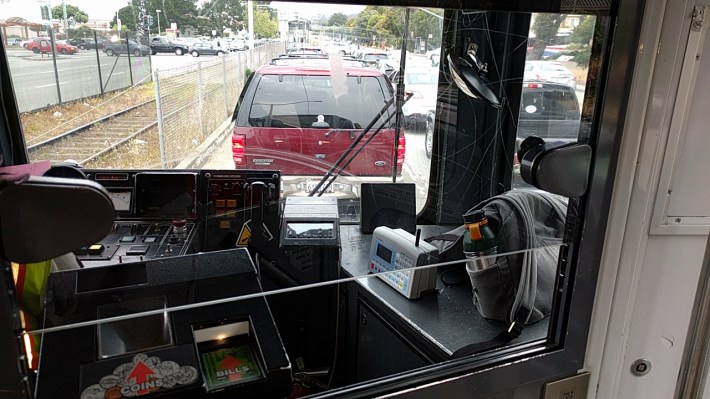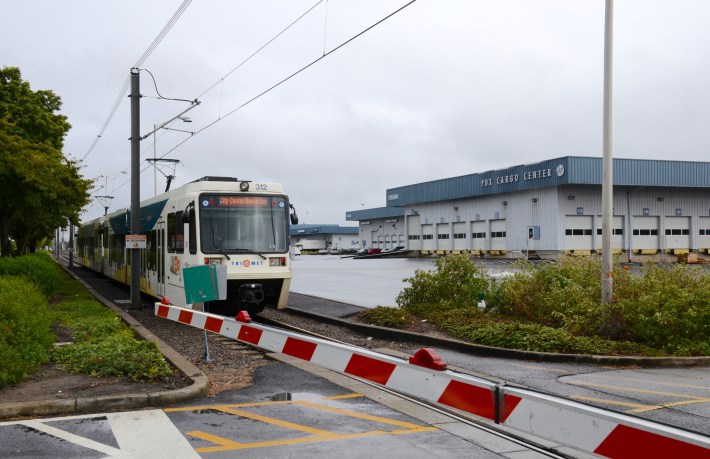
Thursday, SFMTA joined several agencies at the Bay Area 2040 open house in Oakland. One of the projects presented was the M-Ocean View improvement plan. As the Examiner reported today, SFMTA is now leaning towards an all-underground option, with a tunnel stretching from West Portal to Parkmerced. This project, at around $3 billion, would re-align the M-Ocean View to the west of 19th Ave. and put it in a tunnel. Ostensibly, the project's objective is to increase capacity and the speed of the trains to better serve SF State and the burgeoning community of Parkmerced.
From the SFMTA's factsheet from the section entitled, "Key Benefits of Full Subway" PDF:
MUNI METRO SPEED AND RELIABILITY: No delay to train from waiting at intersections [emphasis added] makes for faster and more reliable service. Undergrounding the M- and K-lines through West Portal also addresses this major bottleneck
Somebody has to point out the elephant in the room.
Why is the train waiting at intersections in the first place?
The M-Ocean View, for its run down 19th, has its own right-of-way. But at each intersection, it has to wait for lights to cycle and automobiles to cross.
Obviously, putting the train in a tunnel is not the only solution.
Liz Brisson, Project Manager, Urban Planning Initiatives Sustainable Street Division for the SFMTA, explained at Thursday evening's open house that there are short-term improvements to the M-Ocean View in the works, such as giving it more priority at signal lights and reducing the length of the turning pocket, seen in the photo above, at Stonestown. Right now an inbound M-Ocean View train has to wait behind left-turning cars before it can proceed into the Stonestown station.
But why just shorten the turning pocket? Why not get rid of the one that's blocking the trains? And why signal "priority" instead of pre-emption: meaning why not when the train approaches, gates come down or the light always turns red for the cars and green for the train? The answer is obvious: it will cause more delay for privately owned cars.
The SFMTA's studies also say the train goes slow because of closely spaced stations and that some stops should be eliminated and consolidated. But stop consolidation doesn't require tunnels.
As this publication has covered for many years, San Francisco has long had a "transit first," policy, at least in theory. But what clearer example could there be that transit is still far from first, when trains full of hundreds of people have to sit behind cars turning into a shopping mall?
Certainly, projects to create bus-only lanes on Van Ness, Mission and Geary are a step in the "transit first" direction. But putting Light Rail trains in a tunnel, when they already have a right of way (ROW), doesn't sound like "transit first." It sounds like a way to get the train out of the way of the cars.

In fact, the M-Ocean View study still smacks of a "Level of Service" (LOS) philosophy, where transit can be improved only if it does not have averse effects on peak automobile travel times. Although LOS is no longer the law of the land, it persists in planning bureaucracy.
Meanwhile, students at SFSU have worked out a plan to connect the university and Parkmerced comfortably with the nearby Daly City BART station by bike, so it should only take ten minutes to cycle between that station and the campus. BART takes less than 15 minutes from Daly City to downtown San Francisco. That would cost pennies compared to under-grounding the M-Ocean View.
And in fairness, the SFMTA study has some good ideas, such as eliminating a parking lane from 19th, adding a protected bike lane, and building bulb outs to make it safer to cross the street.
But with all the transportation needs in the Bay Area, is building a tunnel where there's already an existing ROW really the best way to spend $3 billion?




